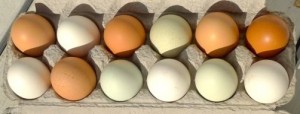Food
by Cecil Poole
Food has always been important to me. Fresh, home grown food more so. Vegetable gardens, herbs, mutton, poultry. With bursts of seasonal foods, like field mushrooms, asparagus, and the fabulous black mulberries. Eating in South East Asia seems to me the pinnacle of fresh food, with the vast array of greens, peppers, lemon grass, cilantro, the basils and mints, all making the most of the meat proteins available.
My daughter in law, (hereafter The d.i.l.) here in North Carolina, has always been enthusiastic about searching out local food. On my frequent visits she invariably takes me to one farm or another. These farms grow a multiplicity of foods, producing eggs, greens, roots vegetables, fruits and berries, corn (of course), milk, and meats of all descriptions. They are mostly organic farms, they use guard dogs to protect the free range chickens. I see Great Pyrenees, Anatolian Shepherds and, perhaps the most common, Maremma. These dogs are extraordinary to watch, I’ve seen them lying seemingly asleep, with chickens eating grass between the dogs stretched out forelegs.
When we visit farms my young grandchildren come too. I sometimes think they love stomping in the puddles and in the mud above all else
We get our eggs from one of the staff at the Day Care, she has fifty or sixty layers.  In a dozen eggs we can have quite an array of different eggs – light blue/green, pure white, brown, speckled, large, small, even some double yolks, just as you would expect from a non-factory farm. The eggs have beautiful rich deep coloured yolks, and whites that whip up to a good stiff peak. The d.i.l. and I have yet to work out the seasonal difference in the eggs, the difference that their food makes to the physiology of the egg – what it is that makes them better for one sort of use over another. The Swiss, reputedly, had a very good understanding of the seasonal differences in eggs, and would cook accordingly.
In a dozen eggs we can have quite an array of different eggs – light blue/green, pure white, brown, speckled, large, small, even some double yolks, just as you would expect from a non-factory farm. The eggs have beautiful rich deep coloured yolks, and whites that whip up to a good stiff peak. The d.i.l. and I have yet to work out the seasonal difference in the eggs, the difference that their food makes to the physiology of the egg – what it is that makes them better for one sort of use over another. The Swiss, reputedly, had a very good understanding of the seasonal differences in eggs, and would cook accordingly.
The d.i.l. goes to some length to buy local foods. I asked her why this was so important to her and she answered that she felt better knowing exactly where her food was coming from, knowing who had grown it. She wanted to be able to show her children where it came from, to share the wonder that is nature providing.
I thought about this term – “nature providing”. I thought about how accepting this term is, how non deterministic. About how different this is from the agriculture I have been part of, where I, the farmer worked almost against nature, trying to control every variable, building myself up as the grower of the food and fibre.
Then I thought of my times in the Tanami desert of central Australia, home of the Walpri people.  The times when they generously took me into their country and showed me “nature providing”, in the form of bush potato (yams), honey ants, goanna (the cooked tail is the part given to me), kangaroo – again the tail is a delicacy, witchetty grubs, and bush tomatoes – just a small array of the foods “nature provides” in this “desert”.
The times when they generously took me into their country and showed me “nature providing”, in the form of bush potato (yams), honey ants, goanna (the cooked tail is the part given to me), kangaroo – again the tail is a delicacy, witchetty grubs, and bush tomatoes – just a small array of the foods “nature provides” in this “desert”.
It seemed as though the Walpri believed that nature would willingly provide. We, of course, know better. Force, coercion, control and plenty of inputs are the determinants of providing in our society. Obviously.
Ah well, back to the factory (farm).
To be continued
